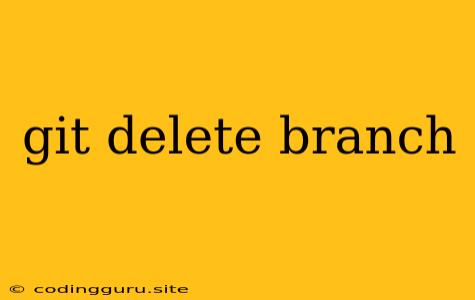How to Delete a Git Branch: A Comprehensive Guide
Git branches are a powerful feature that allows developers to work on different versions of their code simultaneously. This is particularly useful for implementing new features, fixing bugs, or experimenting with different approaches without affecting the main branch. However, once you're done working on a branch, you might need to delete it to keep your repository organized.
When to Delete a Git Branch?
- Completed Feature or Bug Fix: Once a feature is implemented or a bug is fixed, and the code is merged into the main branch, the branch can be safely deleted.
- Experimentation: If you've created a branch for experimentation, and the results aren't promising, or the changes are not required, you can delete the branch.
- Cleanup: Regularly deleting branches that are no longer needed keeps your Git repository clean and easy to manage.
How to Delete a Git Branch
Deleting a Git branch is a simple process that involves two main steps:
-
Switch to a Different Branch: It's crucial to ensure you are not currently on the branch you want to delete. If you are, switch to another branch (often the main branch) using the
git checkoutcommand.git checkout main -
Delete the Branch: Once you're on a different branch, use the
git branch -dcommand to delete the target branch.git branch -d- Replace
<branch-name>with the actual name of the branch you want to delete.
- Replace
Example: To delete a branch named "feature-x," use the command:
git branch -d feature-x
Handling Merged Branches
If the branch you want to delete has already been merged into another branch, you can use the -D option for the git branch command. This option forces the deletion, even if the branch has not been merged.
git branch -D
Caution: Use the -D option with caution as it will not prompt for confirmation and will permanently delete the branch without the possibility of recovery.
Deleting Remote Branches
To delete a branch from a remote repository, use the following commands:
-
Delete the local branch: If you have a local copy of the remote branch, delete it first using the
git branch -dcommand.git branch -d -
Delete the remote branch: Use the
git pushcommand with the--deleteoption.git push origin --delete- Replace
<branch-name>with the actual name of the branch. - Replace
originwith the name of the remote repository (usuallyorigin).
- Replace
Troubleshooting Branch Deletion
If you encounter an error while deleting a branch, it's likely due to one of the following reasons:
- Unmerged Changes: You might have unmerged changes in the branch you're trying to delete. Resolve these changes before attempting to delete the branch.
- Branch Not Merged: If the branch has not been merged, you'll receive an error message. Use the
-Doption to force the deletion. - Remote Branch Still Exists: If you're trying to delete a local branch that still exists on the remote repository, make sure to also delete it from the remote repository.
Tips for Efficient Branch Management
- Descriptive Branch Names: Use descriptive branch names that clearly indicate the purpose of the branch.
- Keep Branches Small: Avoid creating large, monolithic branches. Break down work into smaller, more manageable branches.
- Regularly Clean Up: Periodically check your repository for unused branches and delete them.
Conclusion
Deleting Git branches is a crucial part of maintaining a clean and organized repository. By following the steps outlined in this guide, you can easily delete branches that are no longer needed. Remember to use the -D option with caution, and always double-check that the branch you're deleting is no longer required.
